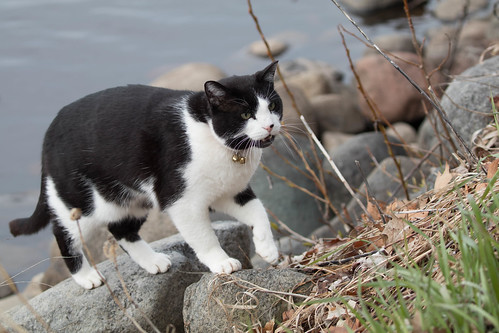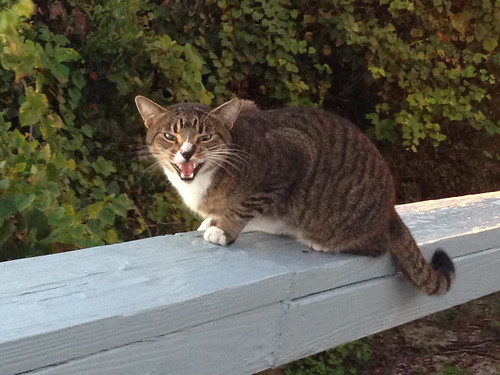On November 1, barely an hour before I presented my monthly Zoom presentation, about woodpeckers, I decided I should include some ways that we humans can help them. One of the ways is to keep cats indoors. Over my years as a wildlife rehabber, I had dealt with a few woodpeckers who had been injured by cats. They had all died from internal injuries or infections, but that was before I was taking many photos. So I posted a request on Facebook to a group of rehabbers asking if anyone had a photo of a cat-injured woodpecker—I'd need it within 10 or 15 minutes. Instantly people sent me several tragically gruesome photos.
And these were just woodpeckers—had I needed photos of generic birds killed by cats, I'd have had dozens in five minutes!
Cats kill roughly a billion birds of a great many species every year in the United States alone. Cat rescue organizations sometimes dispute the numbers, but that's tricky now that a great many different people, using various methodologies, have concluded pretty much the same thing. Some cat defenders say it doesn't really matter because the number of birds killed in collisions with windows is even bigger, as if doctors said it was perfectly okay to consume known carcinogens because heart disease kills more people than cancer.
My cat Kasey had been part of an early trap-neuter-release program in Ohio, eating birds in my daughter's backyard until I brought her home in 2006. We had her declawed right away because our nine-year-old cat Miss Kitty had been declawed and would be defenseless against a well-armed, spunky young cat. We of course kept Kasey indoors, and overall she seemed happy, but she managed to sneak out four times over the years during construction projects or other hectic times, and even without claws she killed and brought home at least one animal, usually a chipmunk, all four times. Once, before we even discovered that she'd made it out, she'd piled up three or four animals on our back porch, including two little songbirds. The worst time was when we had filled a basement window opening with cardboard until the replacement window pane arrived. Kasey discovered it and was going in and out without us noticing. She managed to line up a dead mother deer mouse, her litter of 6 baby mice, and a White-throated Sparrow on our kitchen rug before we figured out what was happening. Cats, by nature, kill. And my sweet cat, in excellent health after regular meals and all the vet care we got for her when I brought her home, was in prime condition to do a lot of damage, even without claws.
Foxes, hawks, and other natural, wild predators die out or move on long before their prey in a given area can be depleted, because they can’t afford to go more than a day or two without a successful hunt. Pet cats allowed to roam, or stray or feral cats fed by people, are not subject to these natural forces—they're subsidized killers. Like my sweet Kasey, these cats don't lose their killer instinct and their urge to toy with living objects just because someone is supplying them with food—those feedings actually put them in better shape to kill more effectively.
When I was a rehabber, I spent a lot of time educating people about birds. I understand how widespread ignorance about the natural world is—I myself was valedictorian of my high school and graduated from college with high honors before I learned anything at all about birds, ecology, or the balance between natural predators and prey. And it wasn’t until I actually became a wildlife rehabber that I discovered that bird wounds stop bleeding so quickly that even very serious injuries aren’t noticeable at all without a close and careful examination. Where are people supposed to learn that bird lungs are set against the back ribs, beneath very thin skin? A single cat scratch or bite on the back virtually always damages the lungs. When people “rescue” a bird from their cat and set it free, that bird is essentially doomed to die from the injury hours or days later.
People who brought me birds their cats had injured invariably felt virtuous and righteous for “saving” the bird. They may have gone to some lengths to put it in a box and drive it to me, but almost every one of those cat-injured birds died anyway. Despite antibiotics and veterinary care paid for out of my own pocket, the internal injuries and infections were usually fatal. It was endlessly frustrating trying to explain this to people. One woman in particular brought me at least a dozen birds her cat had injured. I spent at least five hundred dollars treating just the birds she alone brought me, and because I’m not a non-profit, I was prohibited by federal law from either charging or accepting donations from her or anyone else for my rehab work, not that she even offered to cover my expenses. The financial toll was bad enough—as a stay-at-home mother, I wasn’t bringing in any money at all—but the emotional toll on me and also on my children watching these beautiful, doomed birds struggle to stay alive was far, far heavier. But that woman was utterly oblivious, driving away each time feeling smugly virtuous, thinking she had done the best she could for that poor bird, and never once seriously considering keeping her cat indoors.
For some reason, a great many people seem to believe that because cats act so independent and self-sufficient, we aren't responsible for their actions. I’m a dog person, but the cats that I’ve allowed into my life and heart were dearly loved and cared for. When we take in a cat, its life and well-being, and also its actions, become entirely our responsibility.
People with the means and will to trap and neuter unowned cats have the same moral obligations toward them that people who have dogs, other pets, or farm animals do: keep the animals safe and don't allow them to harm other people or creatures.
People once allowed dogs to roam as they still do cats. Now cats are the top rabies carrier of all domesticated animals, and many individual feral cats are extremely aggressive and dangerous to humans as well as wildlife. The last time Russ and I were on Jekyll Island in Georgia, we got up early to walk from our cabin to the beach along a boardwalk. A feral cat sitting on the guardrail hissed fiercely at us. The beach vegetation was too vulnerable for us to step off the boardwalk, so we had to walk single file against the opposite railing to get past it. That cat was a genuine menace.
The tragic way America solved the dog problem was for just about every jurisdiction to start requiring owned dogs to be licensed and kept under the owner’s control everywhere except on the owner’s actual property. Animal control officers searched for and caught loose dogs; if no one claimed one within a specified length of time, it was adopted out or, more often, euthanized. It was a terrible solution, yet the only way to solve a terrible problem. It's genuinely shameful that dogs paid the penalty for people being so irresponsible in the first place.
Now the cat problem needs the same horrible solution. Euthanizing unowned cats is sad, but not removing them from the wild causes orders of magnitude more death. Yes, cat lives are valuable, but so are bird lives.
Imagine a doctor who keeps one patient alive by draining all the blood from 100 other people, and then boasts about saving that one life. That is what people supporting trap-neuter-release programs, or people intentionally letting their cats outdoors, are doing. Closing their eyes to avian suffering and death, to the tune of a billion birds every year, is unconscionable.








